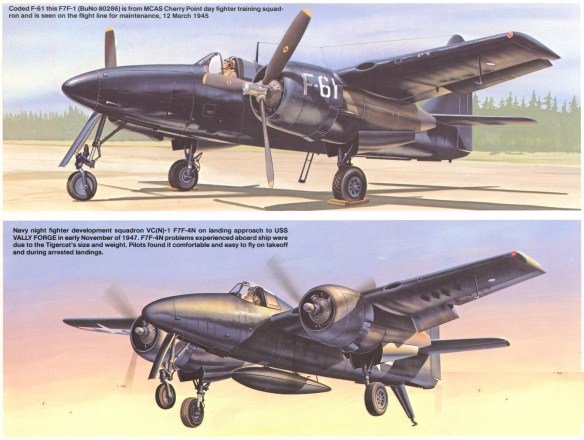The mighty Tigercat was the Navy’s first twin-engine fighter. It arrived too late to see service during World War II, and it accrued only a brief record in Korea before being replaced by jets. In early 1941, Grumman began design-work on a new twin-engined fighter for the War Department, for use on a planned larger Midway-class aircraft carrier.
In 1941 the Navy sought to develop a fighter of unprecedented firepower and speed. Grumman responded by proposing the XF7F, a radical departure from carrier fighters of the day. On June 30, 1941, Grumman was awarded a contract to build two prototypes, the first of which flew in December 1943. The XF7F-1 Tigercat was unusual for a fighter, with its shoulder-mounted wings, twin underwing-mounted engines, all-metal construction and tricycle landing gear. This was the first twin-engine design of its class as well as the first such craft equipped with tricycle landing gear. It was very heavily armed by standards of the day, carrying no less than four machine guns in the nose and four cannons in the wing roots. The Navy was intrigued by having it serve as a ground-attack aircraft for the Marine Corps, and in 1943 the prototype successfully flew.
Before the prototype even flew for the first time, Grumman was contracted to build 500 of them for the US Marine Corps, to be used as close-support aircraft for the massive landing operations then underway in the Pacific. Delivery began in April 1944. The first 34 F7F-1s were similar to the prototypes, then 30 two-seat night-fighter variants (called F7F-2Ns) were produced. Next, 189 single-seat models called F7F-3s were built which featured slightly more powerful R-2800 engines, slightly larger vertical stabilizers, and a 7% increase in fuel capacity.
By 1945 several squadrons had been deployed in the Pacific. However, World War II ended before the powerful fighter saw real combat. A total of 346 had been built by 1946. Less than 100 Tigercats were built after the war as night-fighters (F7F-3N and F7F-4N), electronic reconnaissance (F7F-3E) and photo-reconnaissance (F7F-3P) platforms.
Of several variants built, the F7F2 was unusual in serving as a two-seat night fighter. In this variant, the nose armament was dropped in favor of radar, and the rear gas tanks were eliminated in favor of a second crew member. As good as the Tigercat was, however, it was hopelessly outclassed by the new jet fighters then under development. When the Korean War broke out in 1950 several squadrons were on hand in Japan, and they fought extremely well in support of ground operations. The nightfighting F7F2s also scored kills against a difficult target, the slow North Korean PO2 biplanes, which harassed Allied troops at night. After the war the F7F continued flying with reserve units until 1954. A handful continue serving as civilian firefighters.
Specifications (F7F-3):
Engines: Two 2,100hp Pratt & Whitney R-2800-34W Double Wasp 18-cylinder radial piston engines
Weight: Empty 16,270 lbs., Max Takeoff 25,720 lbs.
Wing Span: 51ft. 6in.
Length: 45ft. 4.5in.
Height: 16ft. 7in.
Performance:
Maximum Speed at 22,200 ft: 435 mph
Cruising Speed at 5,000 ft: 222 mph
Initial Climb Rate: 4,500 feet per minute
Ceiling: 40,700 ft.
Range: 1,200 miles
Armament:
Four 20mm (0.79-inch) cannon in wing roots
Four 12.7mm (0.5-inch) machine guns in nose
One torpedo under fuselage
2,000 lbs. of bombs (1,000 lbs. under each wing)
Number Built: 364
